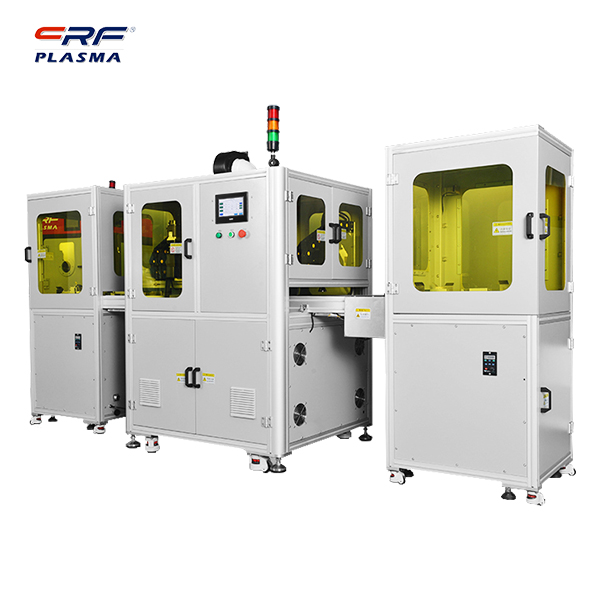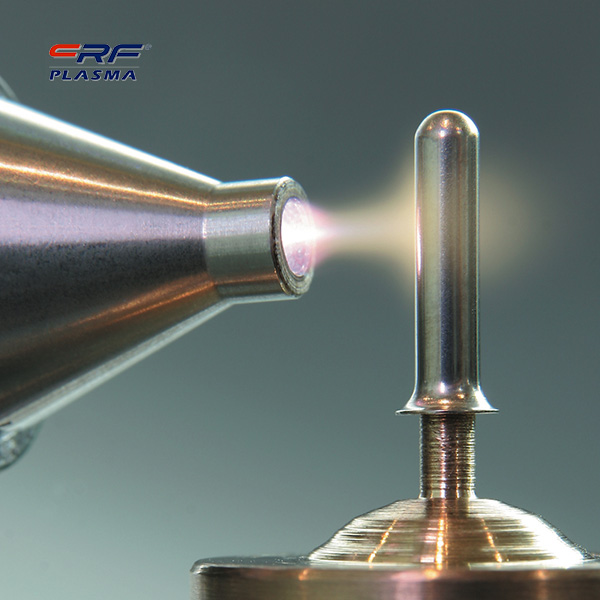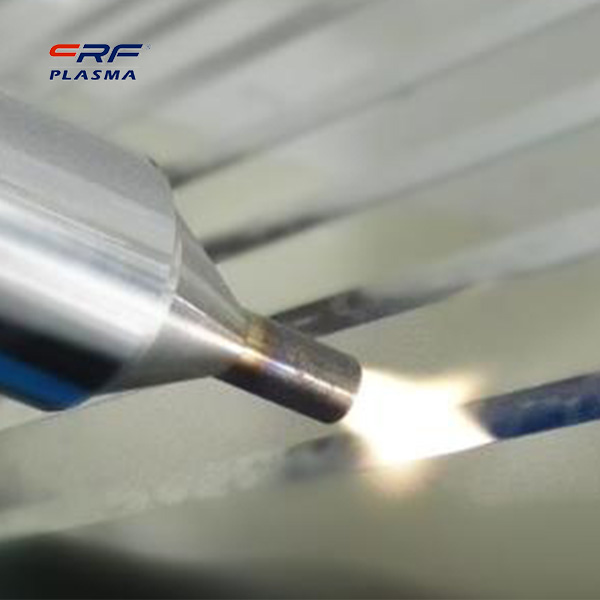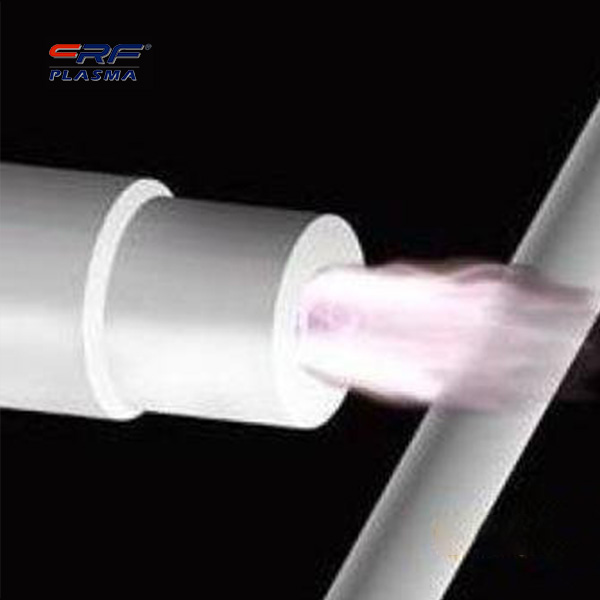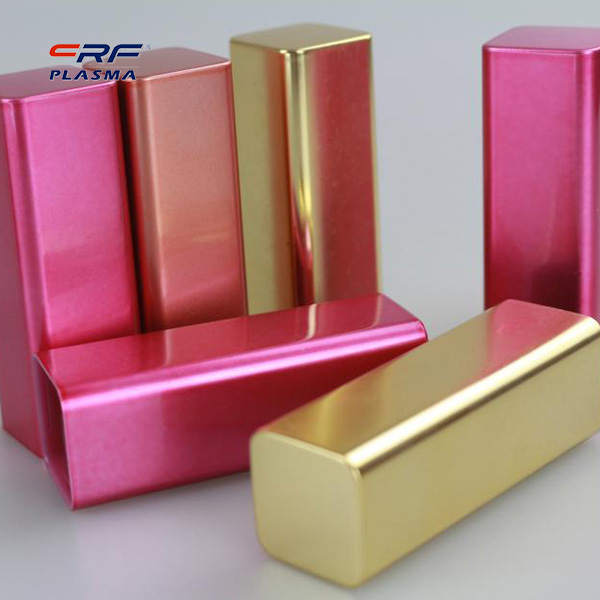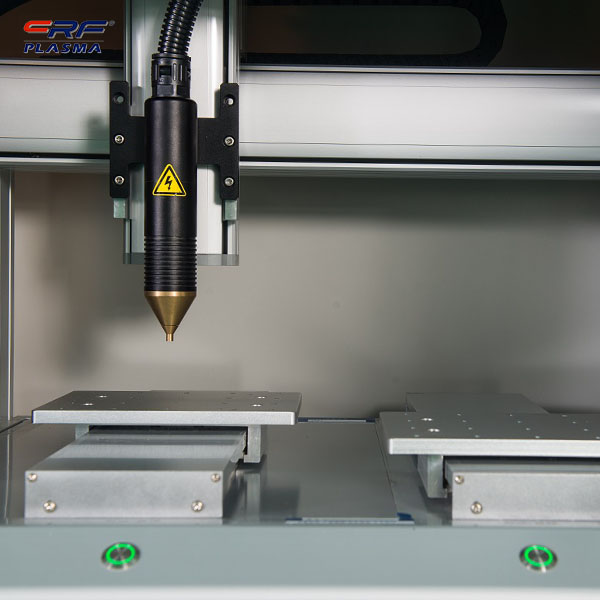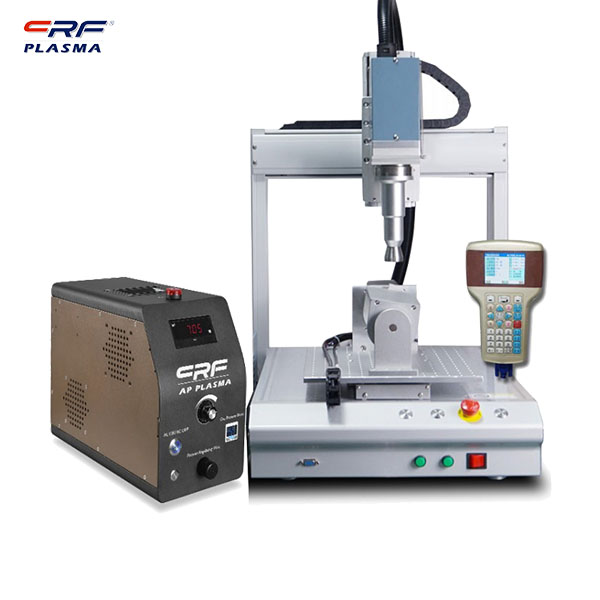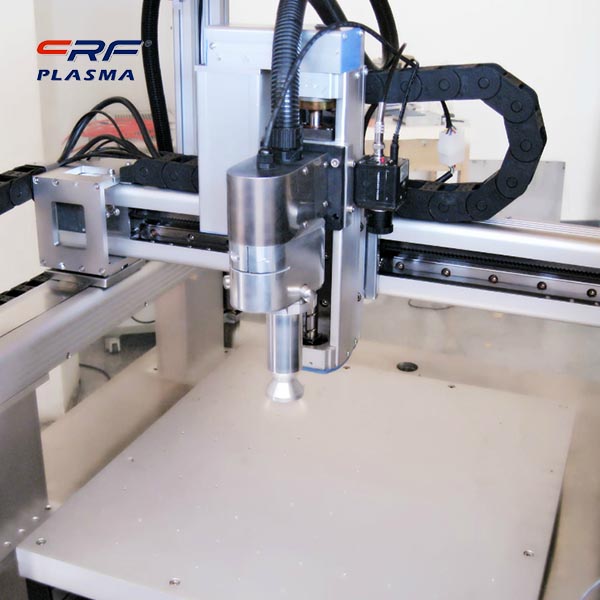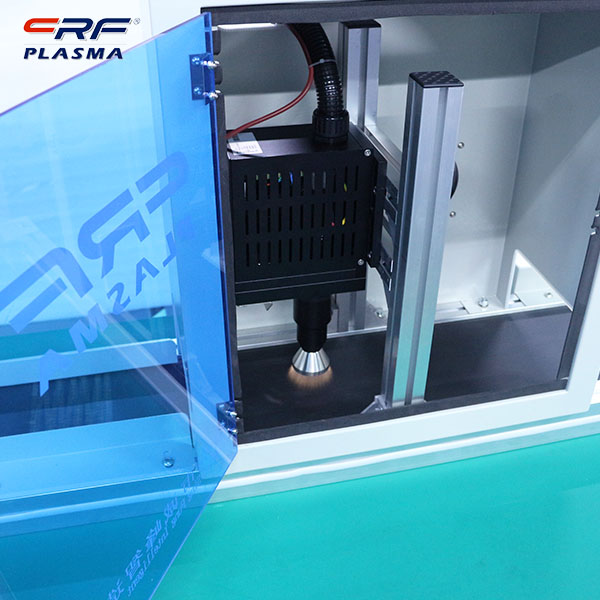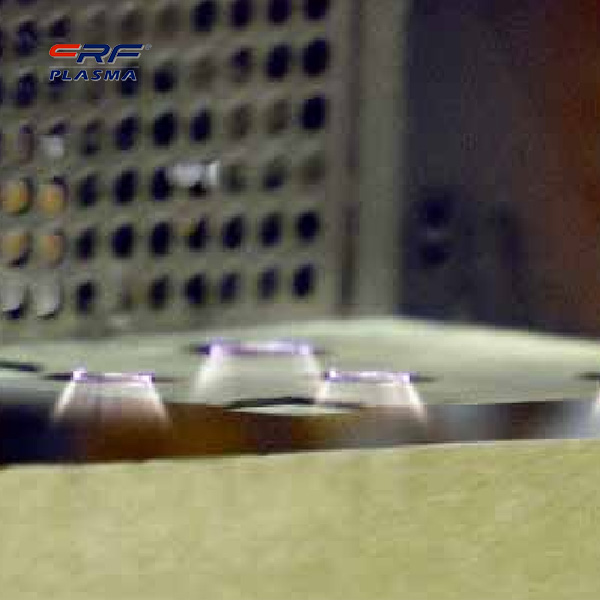
Welcome to Shenzhen Sing Fung Intelligent Manufacturing Co., Ltd.
E-mail:shaobo@sfi-crf.com
Plasma surface modification of bast fiber in atmospheric plasma cleaning equipment
- Categories:Industry News
- Author:Plasma cleaning machine-CRF plasma plasma equipment-plasma surface treatment machine manufacturer-chengfeng intelligent manufacturing
- Origin:
- Time of issue:2021-12-07
- Views:
(Summary description)Plasma surface modification of bast fiber in atmospheric plasma cleaning equipment: During the plasma treatment of fibers and polymers by the atmospheric plasma cleaning equipment, the high-energy particles and photons generated by the plasma interact violently with the surface of the substrate, and this interaction usually manifests as a free radical chemical reaction. Generally, four surface effects can be observed, namely, surface cleaning, surface etching, molecular cross-linking near the surface, and changes in surface chemical structure. To a certain extent, each effect may exist, but one of the effects may be more obvious than others, depending on the processing object, the chemical properties of the gas, and the instrument model and the settings of the instrument parameters. Several surface effects, alone or in synergy, will affect the adhesion of the processed object. Plasma treatment of atmospheric plasma cleaning equipment has a very good effect on improving the bonding strength between polymer and fiber and between polymer and polymer. The increase in adhesion after plasma treatment is due to the increase in the wettability of the substrate and the change in the chemical structure of the polymer surface after treatment. The gas generates a plasma medium under the coupling action of electromagnetic force. This plasma medium contains ions, electrons, neutrons, photons, free radicals, metastable excited particles and molecules, and dynamic mixing at room temperature. Plasma treatment can make The surface of fibers and textiles is functionalized without affecting their overall performance. Under the action of electromagnetic field, these plasma particles diffuse into the surface of the fabric substrate in a gradient, resulting in a variety of general surface treatments, including surface activation of active sites due to bond breakage, grafting of chemical structures and functional groups, and material volatilization Removal (etching), surface contaminants or layer dissociation (cleaning), and deposition of conformal coatings, etc. The electron collision and photochemical molecular separation of atmospheric plasma cleaning equipment will generate plasma containing high-density free radicals, which can cause the chemical bonds on the surface of the fiber polymer to break, thereby forming new chemical substances on the surface of the fiber polymer. This will lead to changes in the chemical structure and morphology of the fiber surface. The specific surface area of the fiber will increase significantly. Plasma treatment on the surface of fibers and polymers will lead to the production of new functional groups such as hydroxyl (-OH), aldehyde (-CHO) and carboxyl (-COOH), which affect the moisture absorption of the fabric and facilitate the grafting of molecules deal with. The unique physical and chemical properties and temperature range characteristics of plasma. Make it an effective tool for surface treatment of materials. The low-temperature plasma treatment of atmospheric plasma cleaning equipment can improve the dyeing rate, dye uptake and color yield of linen fabrics. The etching and oxidation of the hemp fiber surface reflects the effect of plasma treatment. For fiber products with low color fastness, low-temperature plasma dyeing can be considered. Satisfactory dyeing results can usually be obtained. Plasma treatment can achieve effects that cannot be achieved by conventional treatment. Plasma can only act on the surface of the substance (the upper layer) instead of the entire material. The high cost of the treatment process can be repaid by high value-added products. The application space of plasma technology is huge. Generally speaking, the development of plasma technology in the industrial revolution is relatively slow, but it can develop steadily.
Plasma surface modification of bast fiber in atmospheric plasma cleaning equipment
(Summary description)Plasma surface modification of bast fiber in atmospheric plasma cleaning equipment:
During the plasma treatment of fibers and polymers by the atmospheric plasma cleaning equipment, the high-energy particles and photons generated by the plasma interact violently with the surface of the substrate, and this interaction usually manifests as a free radical chemical reaction. Generally, four surface effects can be observed, namely, surface cleaning, surface etching, molecular cross-linking near the surface, and changes in surface chemical structure.
To a certain extent, each effect may exist, but one of the effects may be more obvious than others, depending on the processing object, the chemical properties of the gas, and the instrument model and the settings of the instrument parameters. Several surface effects, alone or in synergy, will affect the adhesion of the processed object.
Plasma treatment of atmospheric plasma cleaning equipment has a very good effect on improving the bonding strength between polymer and fiber and between polymer and polymer. The increase in adhesion after plasma treatment is due to the increase in the wettability of the substrate and the change in the chemical structure of the polymer surface after treatment.
The gas generates a plasma medium under the coupling action of electromagnetic force. This plasma medium contains ions, electrons, neutrons, photons, free radicals, metastable excited particles and molecules, and dynamic mixing at room temperature. Plasma treatment can make The surface of fibers and textiles is functionalized without affecting their overall performance.
Under the action of electromagnetic field, these plasma particles diffuse into the surface of the fabric substrate in a gradient, resulting in a variety of general surface treatments, including surface activation of active sites due to bond breakage, grafting of chemical structures and functional groups, and material volatilization Removal (etching), surface contaminants or layer dissociation (cleaning), and deposition of conformal coatings, etc.
The electron collision and photochemical molecular separation of atmospheric plasma cleaning equipment will generate plasma containing high-density free radicals, which can cause the chemical bonds on the surface of the fiber polymer to break, thereby forming new chemical substances on the surface of the fiber polymer. This will lead to changes in the chemical structure and morphology of the fiber surface. The specific surface area of the fiber will increase significantly.
Plasma treatment on the surface of fibers and polymers will lead to the production of new functional groups such as hydroxyl (-OH), aldehyde (-CHO) and carboxyl (-COOH), which affect the moisture absorption of the fabric and facilitate the grafting of molecules deal with.
The unique physical and chemical properties and temperature range characteristics of plasma. Make it an effective tool for surface treatment of materials.
The low-temperature plasma treatment of atmospheric plasma cleaning equipment can improve the dyeing rate, dye uptake and color yield of linen fabrics. The etching and oxidation of the hemp fiber surface reflects the effect of plasma treatment. For fiber products with low color fastness, low-temperature plasma dyeing can be considered. Satisfactory dyeing results can usually be obtained.
Plasma treatment can achieve effects that cannot be achieved by conventional treatment. Plasma can only act on the surface of the substance (the upper layer) instead of the entire material. The high cost of the treatment process can be repaid by high value-added products. The application space of plasma technology is huge. Generally speaking, the development of plasma technology in the industrial revolution is relatively slow, but it can develop steadily.
- Categories:Industry News
- Author:Plasma cleaning machine-CRF plasma plasma equipment-plasma surface treatment machine manufacturer-chengfeng intelligent manufacturing
- Origin:
- Time of issue:2021-12-07 17:52
- Views:
Plasma surface modification of bast fiber in atmospheric plasma cleaning equipment:
During the plasma treatment of fibers and polymers by the atmospheric plasma cleaning equipment, the high-energy particles and photons generated by the plasma interact violently with the surface of the substrate, and this interaction usually manifests as a free radical chemical reaction. Generally, four surface effects can be observed, namely, surface cleaning, surface etching, molecular cross-linking near the surface, and changes in surface chemical structure.
To a certain extent, each effect may exist, but one of the effects may be more obvious than others, depending on the processing object, the chemical properties of the gas, and the instrument model and the settings of the instrument parameters. Several surface effects, alone or in synergy, will affect the adhesion of the processed object.
Plasma treatment of atmospheric plasma cleaning equipment has a very good effect on improving the bonding strength between polymer and fiber and between polymer and polymer. The increase in adhesion after plasma treatment is due to the increase in the wettability of the substrate and the change in the chemical structure of the polymer surface after treatment.
The gas generates a plasma medium under the coupling action of electromagnetic force. This plasma medium contains ions, electrons, neutrons, photons, free radicals, metastable excited particles and molecules, and dynamic mixing at room temperature. Plasma treatment can make The surface of fibers and textiles is functionalized without affecting their overall performance.
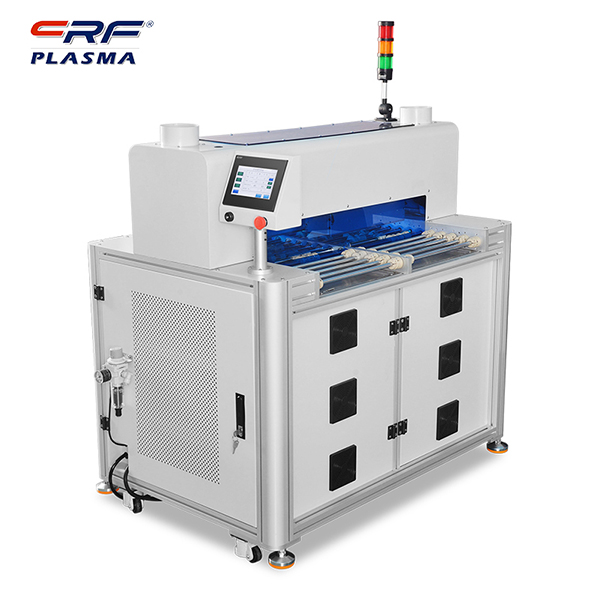 Under the action of electromagnetic field, these plasma particles diffuse into the surface of the fabric substrate in a gradient, resulting in a variety of general surface treatments, including surface activation of active sites due to bond breakage, grafting of chemical structures and functional groups, and material volatilization Removal (etching), surface contaminants or layer dissociation (cleaning), and deposition of conformal coatings, etc.
Under the action of electromagnetic field, these plasma particles diffuse into the surface of the fabric substrate in a gradient, resulting in a variety of general surface treatments, including surface activation of active sites due to bond breakage, grafting of chemical structures and functional groups, and material volatilization Removal (etching), surface contaminants or layer dissociation (cleaning), and deposition of conformal coatings, etc.
The electron collision and photochemical molecular separation of atmospheric plasma cleaning equipment will generate plasma containing high-density free radicals, which can cause the chemical bonds on the surface of the fiber polymer to break, thereby forming new chemical substances on the surface of the fiber polymer. This will lead to changes in the chemical structure and morphology of the fiber surface. The specific surface area of the fiber will increase significantly.
Plasma treatment on the surface of fibers and polymers will lead to the production of new functional groups such as hydroxyl (-OH), aldehyde (-CHO) and carboxyl (-COOH), which affect the moisture absorption of the fabric and facilitate the grafting of molecules deal with.
The unique physical and chemical properties and temperature range characteristics of plasma. Make it an effective tool for surface treatment of materials.
The low-temperature plasma treatment of atmospheric plasma cleaning equipment can improve the dyeing rate, dye uptake and color yield of linen fabrics. The etching and oxidation of the hemp fiber surface reflects the effect of plasma treatment. For fiber products with low color fastness, low-temperature plasma dyeing can be considered. Satisfactory dyeing results can usually be obtained.
Plasma treatment can achieve effects that cannot be achieved by conventional treatment. Plasma can only act on the surface of the substance (the upper layer) instead of the entire material. The high cost of the treatment process can be repaid by high value-added products. The application space of plasma technology is huge. Generally speaking, the development of plasma technology in the industrial revolution is relatively slow, but it can develop steadily.
Scan the QR code to read on your phone

TEL:0755-3367 3020 / 0755-3367 3019

E-mail:sales-sfi@sfi-crf.com

ADD:Mabao Industrial Zone, Huangpu, Baoan District, Shenzhen




